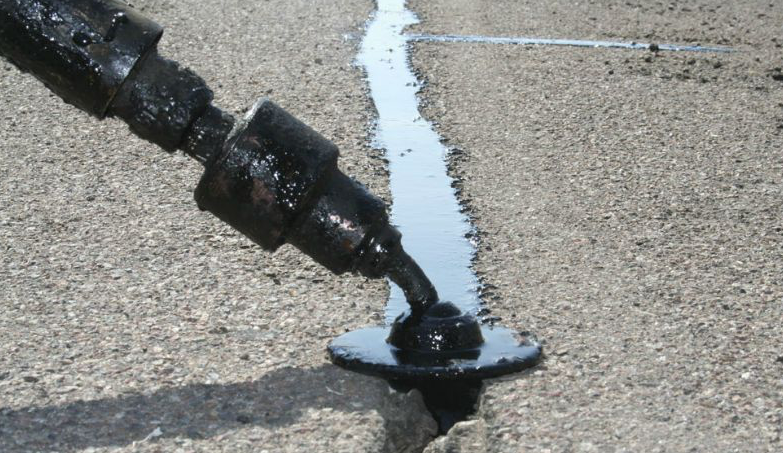Mastering Angled Parking: How Asphalt Sealing Enhances Industrial Lots
Mastering Angled Parking: How Asphalt Sealing Enhances Industrial Lots
Blog Article
Warm Mix Asphalt: A Lasting Solution for Pavement
Warm Mix Asphalt (HMA) has actually emerged as a leading lasting choice for pavement services, offering a myriad of ecological advantages and cutting-edge technologies. As the need for environmentally friendly building practices grows, exploring the nuances of HMA's sustainability can provide valuable understandings right into the future of sidewalk remedies.
Environmental Advantages of Hot Mix Asphalt

In Addition, Hot Mix Asphalt helps to minimize urban warm island impacts. Its dark shade absorbs sunlight, reducing the quantity of warmth showed back into the atmosphere contrasted to lighter-colored pavements. This can reduce ambient temperatures in city locations, reducing the need for a/c and eventually reducing energy usage.
Furthermore, Warm Mix Asphalt adds to improved stormwater administration. Its porous nature permits water to infiltrate the sidewalk and reenergize groundwater supplies, reducing overflow and the danger of flooding. These environmental benefits make Hot Mix Asphalt a lasting option for paving roads and freeways.
Power Efficiency in HMA Production
Is energy performance a critical variable in the production of Hot Mix Asphalt (HMA)? Energy plays a significant duty in the production of HMA, impacting both price and environmental sustainability. One vital element of energy performance in HMA production is the use of warm mix asphalt (WMA) modern technologies.
Additionally, advancements in plant modern technologies have led to even more energy-efficient HMA production procedures. Modern plants are created with features like recycled asphalt sidewalk (RAP) processing capacities, effective heater systems, and enhanced insulation, all adding to energy financial savings. By maximizing energy use in HMA production, the sector can reduce its carbon impact while preserving premium pavement products. Energy performance is, as a result, an essential consideration in guaranteeing the sustainability of Hot Mix Asphalt production.
Recyclability of Warm Mix Asphalt
The recyclability of Hot Mix Asphalt (HMA) is an essential facet of its sustainability and long-term environmental effect. HMA is among the most recycled materials in the United States, with over 100 million heaps of redeemed asphalt pavement (RAP) being recycled annually in new pavement building. Reusing HMA uses a number of ecological advantages, such as reducing the need for virgin materials, reducing power consumption throughout manufacturing, and lowering the quantity of waste sent to garbage dumps.
The process of recycling HMA includes crushing the existing pavement, squashing it right into smaller items, and mixing it with new aggregate and asphalt binder to develop a recycled mix. Generally, the recyclability of HMA plays a considerable role in promoting sustainable techniques within the sidewalk industry.

Long-Term Efficiency of HMA
Asphalt sidewalks show durability and durability over a prolonged duration, showing the long-lasting efficiency of Hot Mix Asphalt (HMA) The longevity this page of HMA can be attributed to its ability to endure heavy traffic loads, severe climate condition, and the impacts of aging. Research studies have revealed that properly designed and effectively created HMA sidewalks pop over to this web-site can last for two decades or even more with routine upkeep. The trick to optimizing the long-lasting performance of HMA hinges on making use of top notch products, complying with best practices in building and construction, and applying efficient upkeep approaches. Correct drain, routine examinations, and prompt fixings are essential for maintaining the structural honesty of HMA pavements over time. In addition, improvements in HMA modern technology, such as making use of polymer-modified binders and cozy mix asphalt, have actually even more enhanced the longevity and durability of HMA pavements. By focusing on top quality construction and maintenance techniques, HMA continues to confirm itself as a lasting and cost-effective remedy for durable pavement framework.

HMA: Longevity and Sustainability
Showing both resilience and sustainability, Hot Mix Asphalt (HMA) has actually ended up being a foundation in the construction of long-lasting sidewalk infrastructures - hot mix asphalt. HMA's durability originates from its ability to hold up against hefty loads, extreme climate condition, and high traffic quantities, making it a reputable selection for roads, freeways, and airport paths. The structure of HMA, which commonly consists of aggregates, binder, and filler, plays a crucial function in improving its long life and resistance to tear and use
Moreover, HMA's sustainability lies in its recyclability and energy-efficient manufacturing procedure. The capability to recycle redeemed asphalt sidewalk (RAP) why not try here in brand-new HMA mixtures lowers the need for virgin materials and reduces the ecological impact of sidewalk building and maintenance. Additionally, the energy efficiency of generating HMA hinges on its lower blending temperatures contrasted to various other sidewalk products, bring about reduced energy intake and greenhouse gas emissions.
Verdict
In verdict, hot mix asphalt (HMA) offers a sustainable remedy for pavement with its ecologically friendly characteristics. HMA's recyclability, energy efficiency in production, and lasting resilience make it an environment-friendly selection for road building.
HMA is one of the most recycled products in the United States, with over 100 million bunches of recovered asphalt pavement (RAP) being reused each year in new sidewalk building and construction.The procedure of reusing HMA involves crushing the existing pavement, squashing it right into smaller items, and blending it with new accumulation and asphalt binder to create a recycled mix.Asphalt pavements show durability and resilience over an extended period, reflecting the long-lasting performance of Warm Mix Asphalt (HMA) Furthermore, developments in HMA modern technology, such as the usage of polymer-modified binders and cozy mix asphalt, have better improved the sturdiness and long life of HMA pavements. The capability to recycle reclaimed asphalt sidewalk (RAP) in new HMA blends lowers the need for virgin materials and minimizes the environmental influence of pavement building and maintenance.
Report this page